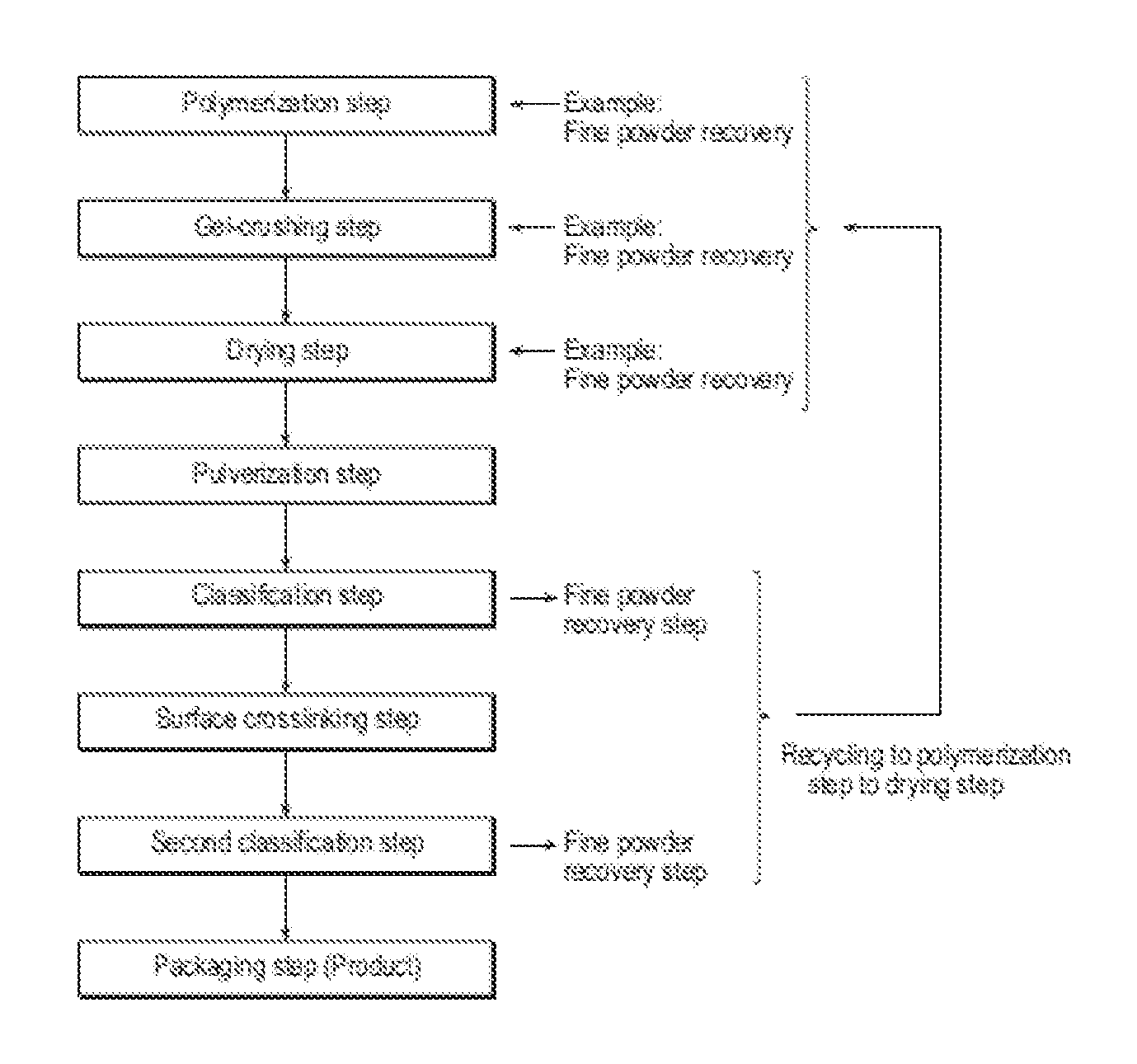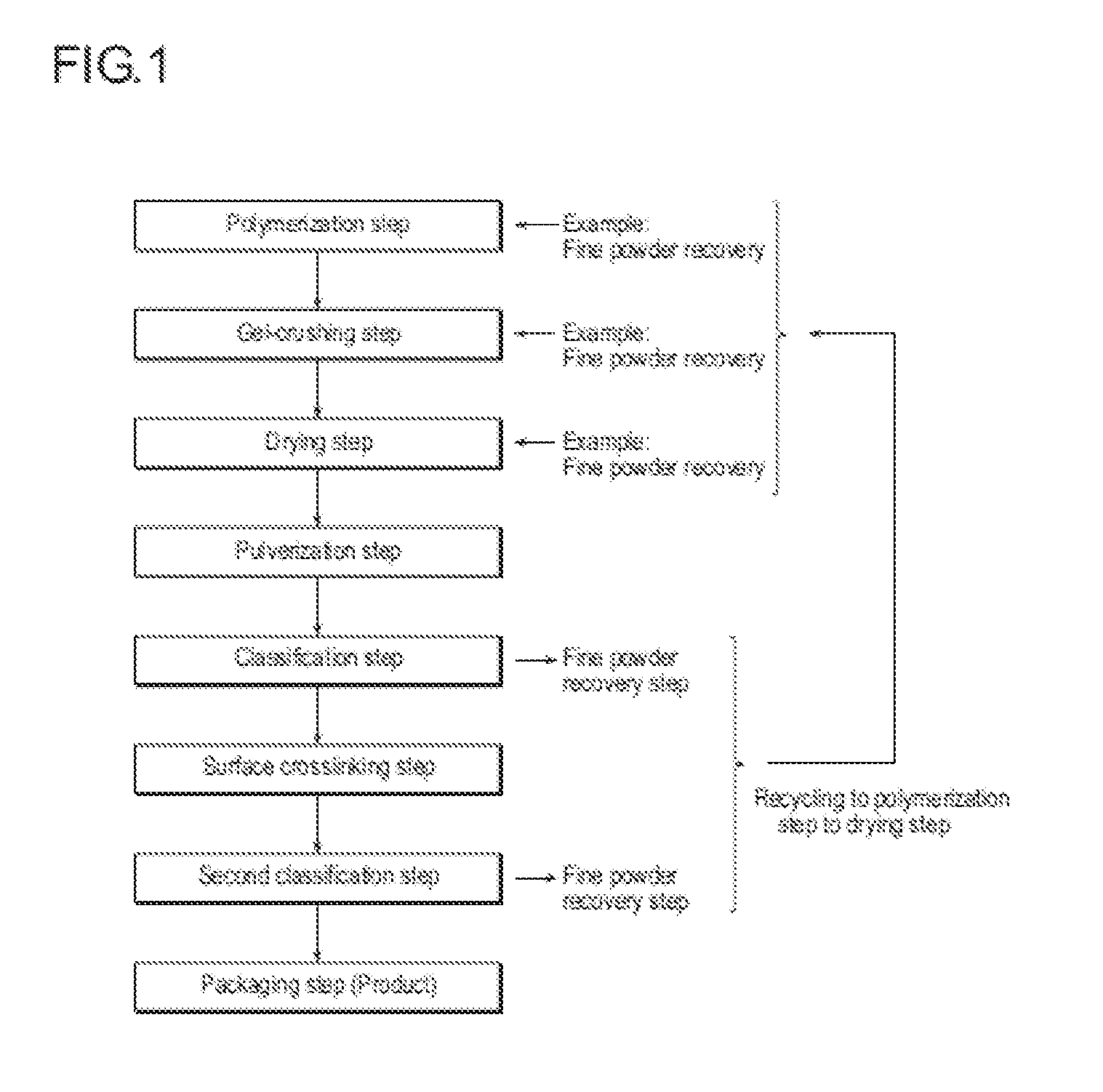Method for producing polyacrylic acid (SALT)-based water absorbent resin powder
a technology of polyacrylic acid and resin, which is applied in the field of producing a polyacrylic acid (salt)-based water absorbent resin powder, can solve the problems of high water absorption rate, insufficient technology, and high raw material cost, and achieve excellent physical properties, high degree of whiteness, and stable physical properties.
- Summary
- Abstract
- Description
- Claims
- Application Information
AI Technical Summary
Benefits of technology
Problems solved by technology
Method used
Image
Examples
preparation example 1-1
[0496](Preparation of Particulate Water-Containing Gel-Like Crosslinked Polymer (1-1))
[0497]In a reactor of double-blade type kneader made of stainless steel, formed by attaching a lid, which is equipped with two sigma-shaped blades and jacket and had an internal capacity of 10 L, 5438 parts by weight of an aqueous solution of sodium acrylate (monomer concentration: 39 wt %) having a neutralization rate of 73 mol %, and 11.3 parts by weight (0.09 mol % relative to the monomer) of polyethylene glycol diacrylate (molecular weight 523) were introduced, and the mixture was dissolved and used as a reaction liquid. Meanwhile, the acetic acid content in the acrylic acid used was 200 ppm, the propionic acid content was 100 ppm, and the p-methoxyphenol content was 70 ppm. Next, this reaction liquid was degassed for 30 minutes under a nitrogen gas atmosphere. Subsequently, 29.34 parts by weight of a 10 wt % aqueous solution of sodium persulfate and 24.45 parts by weight of a 0.1 wt % aqueous ...
example 1-1
[0499](Production of Water-Containing Agglomerated Particles)
[0500]The particulate water-containing gel-like crosslinked polymer (1-1) obtained in Preparation Example 1-1 was dried by using a through-circulation band type hot air dryer having a punching plate (material: SUS304, shape of holes: oval holes arranged in zigzags, size of holes: width 1.2 mm and length 15 mm, ratio of opening area: 27%), under the conditions of a drying time of 35 minutes, a hot air temperature of 150° C., and an average flow velocity of hot air of 1.0 [m / s], and thus a dried substance (1-1) was obtained. Meanwhile, the hot air used for the drying was a gas mixture of water vapor and air, and the dew point temperature was fixed at 60° C. Furthermore, hot air was caused to flow upward in a direction perpendicular to the punching plate surface. The flow rate was measured by using a constant temperature thermal type anemonometer, ANEMOMASTER (registered trademark) 6162 (manufactured by Kanomax Japan, Inc.).
[...
examples 1-2 to 1-9
[0506]The hot air temperature and air flow velocity at the time of drying in the Example 1-1 were changed. That is, the operation was carried out in the same manner as in Example 1-1, except that instead of the drying step (150° C., 1.0 [m / s]) employed in the production of the water-containing agglomerated particles and the production of the water absorbent resin powder, the temperature of the hot air was set to 150° C. (Example 1-4 and Example 1-7), 180° C. (Example 1-2, Example 1-5, and Example 1-8), or 190° C. (Example 1-3, Example 1-6, and Example 1-9), and the average flow velocity of the hot air was set to 1.0 [m / s] (Example 1-2 and Example 1-3), 2.0 [m / s] (Example 1-4, Example 1-5, and Example 1-6), or 3.0 [m / s] (Example 1-7, Example 1-8, Example 1-9). Thus, water absorbent resin powders (1-2) to (1-9) were obtained. Meanwhile, the dew point temperature at the beginning of drying in the drying step of Examples 1-2 to 1-9 was 70° C., and the dew point temperature at the end of...
PUM
| Property | Measurement | Unit |
|---|---|---|
| particle size | aaaaa | aaaaa |
| temperature | aaaaa | aaaaa |
| temperature | aaaaa | aaaaa |
Abstract
Description
Claims
Application Information
 Login to View More
Login to View More - R&D
- Intellectual Property
- Life Sciences
- Materials
- Tech Scout
- Unparalleled Data Quality
- Higher Quality Content
- 60% Fewer Hallucinations
Browse by: Latest US Patents, China's latest patents, Technical Efficacy Thesaurus, Application Domain, Technology Topic, Popular Technical Reports.
© 2025 PatSnap. All rights reserved.Legal|Privacy policy|Modern Slavery Act Transparency Statement|Sitemap|About US| Contact US: help@patsnap.com



